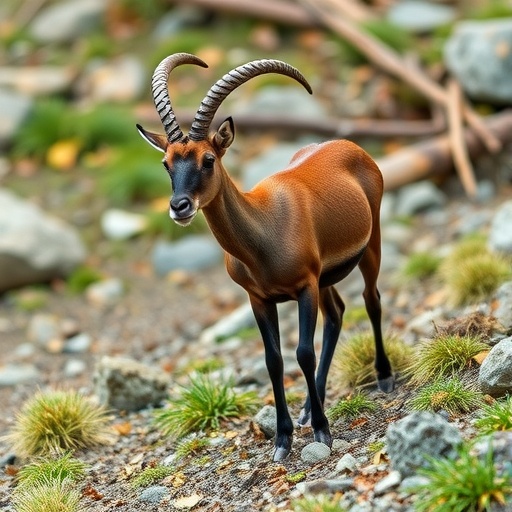In the rugged terrains of mountainous regions, a captivating interplay occurs between predators and their prey. Among these intricate dynamics, the story of the wolf and the chamois (Rupicapra rupicapra) emerges as a compelling example of nature’s relentless pursuit for survival. A recent study, led by researchers Orazi, Panaccio, and Lovari, delves deep into the antipredator behaviors exhibited by these iconic species and how such behaviors significantly influence the altitudinal movements of prey.
As wolves prowl through their alpine territories, they embody the role of apex predators, instilling a constant sense of apprehension among their prey. Chamois, known for their agility on steep slopes, adopt various strategies to mitigate the threat of predation. The comprehensive study highlights that the chamois’s altitudinal movements are not random but are intricately linked to the presence of wolf populations. This establishes a vital connection between predation risk and habitat selection, revealing a sophisticated ecological relationship characterized by adaptive behaviors.
In their quest for survival, chamois exhibit remarkable behavioral adaptations. One noteworthy strategy is their propensity to move to higher altitudes during times of increased predation risk. By seeking refuge in the craggy heights of their mountainous habitat, chamois can exploit the rugged terrain to evade wolf attacks. This behavior is not merely an instinctual response but a learned behavior, honed through evolutionary pressures over millennia. The study underscores the implications of such adaptive movements, suggesting that they can significantly impact local ecosystems and the distribution of species.
Moreover, the research sheds light on the intricate mechanisms that govern these antipredator responses. The authors report that chamois are acutely aware of their environment, continuously scanning for signs of wolves. This vigilance is coupled with their remarkable agility, allowing them to navigate steep cliffs and rocky outcrops with ease. The study posits that the ability of chamois to accurately assess the risks posed by wolves has been instrumental in shaping their altitudinal patterns. Understanding these behaviors provides crucial insights into the dynamics of predator-prey interactions and the broader ecological consequences.
The ramifications of this research extend beyond the immediate predator-prey relationship. By influencing the movements of chamois, the presence and behavior of wolves can alter vegetation patterns within these mountainous ecosystems. The study discusses how the grazing habits of chamois shift in relation to their fear of predation, subsequently impacting plant communities and biodiversity. As herbivores alter their foraging areas, the vegetation dynamics of the region are inevitably transformed, highlighting the interconnectedness of species within these ecosystems.
Investigating the significance of these movements also involves considering the temporal aspects of predation risk. The study reveals that chamois are not only reactive but exhibit proactive behaviors, adjusting their altitudinal ranges according to seasonal changes in wolf activity. During the breeding season, for instance, when wolves are more prevalent, chamois tend to move to higher altitudes, showcasing their adaptability and strategic foresight. Such behaviors raise critical questions about how these species will respond to changes in the landscape, particularly in light of habitat fragmentation and climate change.
Furthermore, the study provides evidence that wolf predation pressure is not uniform across different altitudinal zones. Instead, it varies based on multiple ecological factors, including prey density and availability of hiding cover. This nuanced understanding can aid conservation biology efforts, as effective management strategies must account for these variations in predation risk. It is imperative to recognize that the survival of both wolves and chamois hinges upon a delicate balance shaped by their interactions.
The research team’s findings also serve as a reminder of the significance of apex predators within ecosystems. Wolves, through their predatory behaviors, contribute not only to the regulation of prey populations but also foster the resilience of habitats. By controlling herbivore numbers, they promote plant diversity, creating a richer environment for a myriad of species. Understanding this intricate web of life emphasizes the importance of preserving apex predators, whose presence is critical for maintaining ecological balance.
In conclusion, the study conducted by Orazi, Panaccio, and Lovari offers profound insights into how antipredator behavior shapes the altitudinal movements of chamois, driven by the ever-looming threat of wolves. The intricate relationship between these species highlights the complex dynamics within ecosystems, illustrating the profound impact of predation on behavior and habitat use. In an age of environmental changes and biodiversity loss, such research is vital for informing conservation strategies that seek to protect not only individual species but the integrity of entire ecosystems.
Through illuminating the sophisticated interactions between predators and prey, this research underscores the elegance of nature’s design—a tapestry woven from the threads of survival, adaptation, and ecological balance. As we continue to unravel these connections, we not only gain knowledge of the natural world but also a deeper appreciation for the intricacies of life that surround us.
This monumental research has implications that stretch far beyond the immediate ecosystem, resonating with concerns about conservation, climate change, and the fragile web of life we are all part of. The narrative of the wolf and chamois exemplifies the ongoing struggle for survival in a world of increasing human impact, emphasizing that every action has a ripple effect throughout the environment. As we strive to coexist harmoniously with nature, studies like these serve as vital reminders of the delicate balance we must protect.
Subject of Research: Antipredator behavior and altitudinal movements in chamois affected by wolf predation.
Article Title: Antipredator behaviour as a major determinant of prey altitudinal movements: the wolf and the chamois.
Article References:
Orazi, V., Panaccio, M., Lovari, S. et al. Antipredator behaviour as a major determinant of prey altitudinal movements: the wolf and the chamois.
Front Zool 22, 22 (2025). https://doi.org/10.1186/s12983-025-00559-1
Image Credits: AI Generated
DOI:
Keywords: Predation, antipredator behavior, wolf, chamois, altitudinal movements, ecosystems, conservation.




